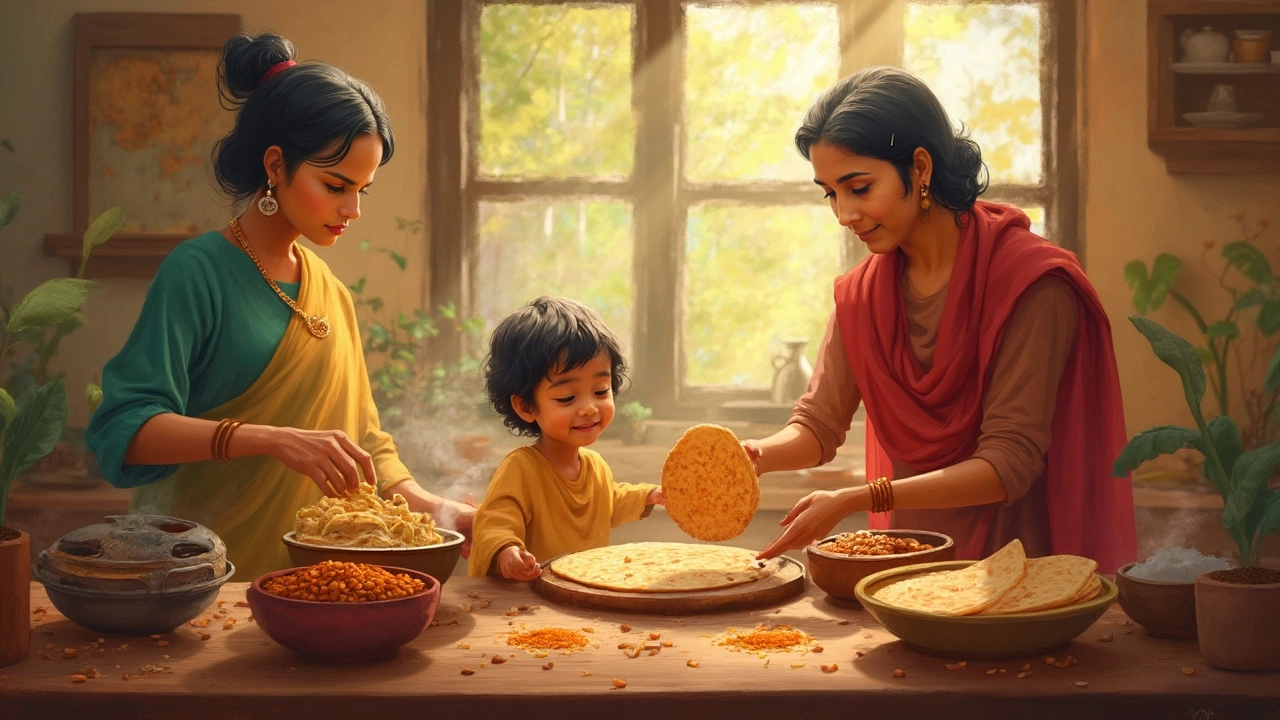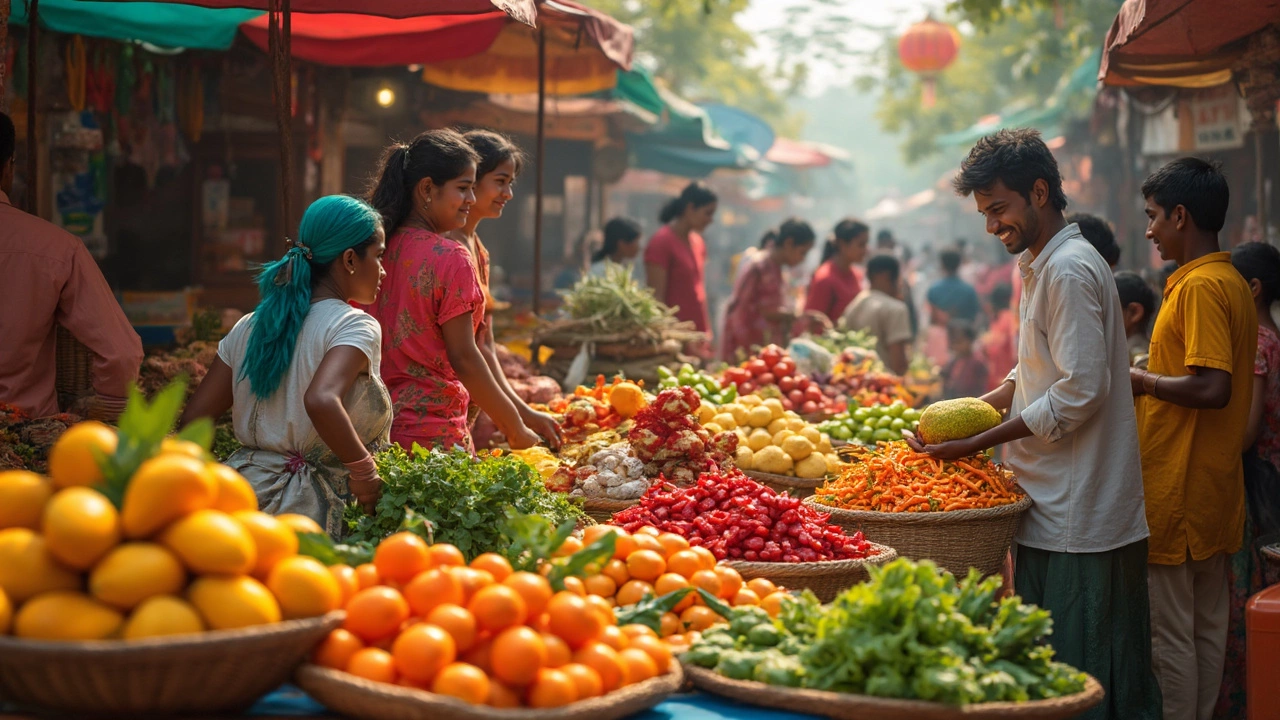When it comes to meat consumption, India stands out. Despite being the second-most populous country, the average Indian consumes significantly less meat compared to other countries. So, why is that? A good part of it boils down to cultural and religious factors. For many Indians, vegetarianism is deeply woven into the cultural fabric, often seen not just as a dietary preference but as a way of life. With religions like Hinduism, Jainism, and Buddhism finding their roots here, the emphasis on non-violence and respect for all living beings plays a crucial role.
But it's not just about tradition. Economic factors also contribute to this trend. For many families, vegetarian meals are simply more affordable and accessible. Let's not forget the vibrant and diverse plant-based recipes Indian cuisine offers. You don't miss the meat when you have so much flavor going on your plate!
- Cultural and Religious Influences
- Economic Factors
- Impact of Globalization
- Simple Indian Vegetarian Recipes
Cultural and Religious Influences
One of the standout reasons why India eats less meat is due to its rich cultural and religious diversity. With a wide array of communities and beliefs, dietary habits vary, but there's a common thread of spirituality and ethical considerations that influences food choices.
Hinduism and the Vegetarian Ethos
More than 80% of Indians identify as Hindus, and many adhere to the principle of ahimsa, meaning non-violence. This principle advocates respect and kindness towards all living creatures, leading to a preference for plant-based diets. Though not all Hindus are vegetarians, there’s a significant number who abstain from meat, especially beef, due to the sacred status of cows in Hinduism.
Jainism: Strict Vegetarianism
Followers of Jainism take non-violence a step further, often following a strictly vegetarian diet. They avoid root vegetables, as uprooting them is seen as harming the plant. This level of consideration shows how deep-rooted these dietary beliefs are, reflecting a profound respect for life.
Buddhism and Vegetarian Traditions
Buddhism, another religion with significant roots in India, also promotes compassion towards animals, though dietary practices vary among its followers. Many Buddhists worldwide embrace vegetarianism inspired by their teachings.
Sikhism and Meat Consumption
Sikhism, another major religion, presents a different perspective. While Sikhs are not required to be vegetarian, the community as a whole respects individual dietary choices. Hence, even within religious boundaries, there are cultural nuances to consider.
These religious beliefs create a societal backdrop where vegetarianism is not just accepted but often celebrated. And the amazing variety of easy Indian recipes makes it a practical and delightful lifestyle choice for many!
Economic Factors
One of the main reasons India eats less meat is because of economics. For many Indian families, meat is a luxury that’s often reserved for special occasions. Daily meals tend to be plant-based because they are more affordable. With a significant portion of India's population living in rural areas, growing vegetables, lentils, and grains is more sustainable. This doesn’t just feed families; it supports the local economy too.
Let’s talk numbers. While the average per capita income in India has seen a rise, a large chunk of the population still falls under the lower economic bracket. In such scenarios, vegetarianism isn’t just a choice; it’s a necessity. Vegetables, legumes, and grains not only form a cost-effective diet but are also healthier.
Consider the price difference. A kilo of chicken might cost anywhere between ₹150-200, whereas a kilo of lentils could be half that amount. This affordability factor makes plant-based meals more appealing for everyday cooking.
Another aspect is the availability. In many regions, vegetables are more readily accessible compared to good quality meat. With vibrant local markets bursting with fresh produce, it's a no-brainer why many prefer a plant-based diet.
| Ingredient | Cost per Kg (INR) |
|---|---|
| Chicken | 150-200 |
| Lentils | 70-100 |
| Vegetables | Varies, usually 30-100 |
In essence, economic factors play a crucial role. They not only affect what's cooked daily but also influence broader cultural and dietary habits, shaping the collective diet of millions of Indians.

Impact of Globalization
Globalization has reshaped diets around the world, and India is no exception. With increased access to international media and diverse cuisines, young Indians, especially those in urban areas, are curious about exploring new flavors. American fast food giants and multi-cuisine restaurants have sprung up in cities, bringing meat-based dishes into the spotlight.
But does this mean India's tradition of vegetarianism is fading? Not necessarily. According to a report by the National Sample Survey Office, even though meat consumption has increased by about 14% over the past decade, vegetarian food remains king in the traditional Indian diet. A vast majority still sticks to vegetarianism, and the interesting part is how globalization has also introduced a variety of non-meat alternatives.
"India's culinary landscape is expanding without losing its roots. The rise in plant-based alternatives is a testament to how traditional and modern can coexist," says renowned Indian chef Gaggan Anand.
The mix of global influences with traditional tastes has led to innovative recipes that embrace the best of both worlds. Paneer tacos, masala spaghetti, and stuffed bell peppers with Indian spices are becoming household favorites. This shows a unique blend where Indian flavors meet global styles.
| Year | Meat Consumption in Million Tons |
|---|---|
| 2015 | 7.2 |
| 2020 | 8.2 |
| 2025 | Projected 9.5 |
While globalization introduces new tastes, many families adapt these influences within a vegetarian framework. It's not just about eating what's available globally but reinventing it with local ingredients and flavors. Navigating through these changes, Indian diet remains a mosaic of old traditions and new experiments.
Simple Indian Vegetarian Recipes
Diving into the world of Indian vegetarian cuisine, you'll find a treasure trove of flavors that's both exciting and accessible, which explains why India is less into meat. These dishes are not only delicious but are often built around ingredients you probably already have in your kitchen.
Spicy Chickpea Curry
Known as 'Chole', this is a favorite in Northern India. You’ll need chickpeas, tomatoes, onions, and a blend of spices like cumin and garam masala. Here’s how you can whip up this dish:
- Sauté diced onions with cumin seeds until golden.
- Add ginger-garlic paste, followed by chopped tomatoes, and cook until soft.
- Toss in the spices and let them mingle for a minute.
- Introduce the boiled chickpeas and some water, simmering until the sauce thickens to your liking.
Serve it with hot naan or steamed basmati rice for a wholesome meal.
Paneer Tikka
If you’re after something more indulgent, then paneer is your best friend. This Indian cottage cheese is a mainstay in vegetarian dishes.
- Cut paneer into cubes and marinate it with yogurt, tandoori masala, and a hint of lemon juice.
- Thread them onto skewers, alternating with bell peppers and onions.
- Grill these for about 10 minutes, turning every so often until they’re browned.
Perfect as a starter or a quick snack.
| Dish | Cooking Time (mins) | Spice Level |
|---|---|---|
| Chole | 45 | Medium |
| Paneer Tikka | 20 | Mild to Medium |
Indian diet revolves around vibrant recipes that make plant-based eating an adventure rather than a chore. So next time you think vegetarian is boring, remember these lively dishes that pack a punch!
